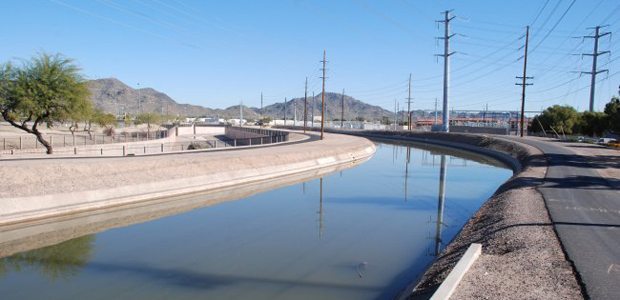Walkers, joggers, bicycle and horseback riders have been recreating on Valley canal banks for decades, and have been invited to do so by the U.S. Bureau of Reclamation and Salt River Project. And, now that these two entities have signed an extension to a 1964 agreement that gave SRP authority to grant use-authorization permits to Maricopa County and Valley municipalities to develop recreation enhancements on these canals, recreational opportunities are likely to be enhanced even further.
When signed in November 1964 by U.S. Secretary of the Interior Stewart Udall, Maricopa County supervisors and SRP executives, the recreation program was the first of its kind in the nation. The original program provided, for the first time, for development of facilities for hiking, picnicking, bicycling and horseback riding along the SRP canal system.
Today, these 130 miles of canals are not only integral to the delivery of water throughout the Valley, they continue to provide the public with recreational opportunities along the canal roads. Through the use of strategically placed monitoring equipment, it is estimated that a minimum of 750,000 people are using the canals for recreation annually.
Leslie Meyers, area manager of the Bureau of Reclamation’s Phoenix Area Office, said, “Reclamation is proud of its 50-year partnership providing for recreational opportunities with SRP. It is Reclamation’s responsibility to provide public recreation opportunities on project lands, and we are very pleased to take this opportunity to celebrate that commitment today and into the future.”
SRP President David Rousseau said allowing public access along canal roads created a safer environment by moving those activities off vehicular roadways. And, since the unique 1964 agreement was implemented, more than 60 miles of the SRP canal maintenance roads have also been improved for public uses, he said.
“Our canal system has really evolved since the original agreement was signed,” he said, citing constructed recreational improvements that now typically include paved trails, landscaping, lighting, public art, signage and user amenities such as signalized street crossings, seating, pet stations, directional signage and shade structures.
“The canals have played a significant role in the Valley’s history, and today there are 25 sites on the canals that are now providing historic interpretation such as signs that explain the role the canals have played in the development of the Valley,” said Rousseau. “Also, the canal system today has a role in the development of the arts, supporting more than $10 million of public art investment for the enjoyment of the public.”
Maricopa County Supervisor Andy Kunasek and Mayors Greg Stanton of Phoenix and John Giles of Mesa also praised the agreement extension.
County Supervisor Kunasek, the Maricopa County Board of Supervisors’ trails champion, said the SRP canal system further expands the trail system in the county. “The canals are a critical segment of the Valley’s off-road urban trail system,” he said, “providing not just 130 miles of canal trails but critical connectivity junctures with other area trail systems.”
“For so many of our residents the canal system is the heart and soul of the community, not just bringing the water our lives depend on, but connecting neighborhoods, cities and providing recreation opportunities,” said Phoenix Mayor Stanton. “We want to improve that connectivity with a Grand Canal trial project that is nearing finalization.” Combined, the county, SRP and Valley municipalities have invested more than $60 million to design and build our existing canal recreation facilities, Stanton added.
Mesa Mayor Giles’ city has about 30 miles of SRP-managed canals within its jurisdiction, along with seven miles of multi-use trails with paved access, lighting, landscaping and user amenities.
“Our current project, the Porter Park Multi-use path, will provide off-street recreational access on the Mesa Canal and is part of the Safe Routes to School Program,” said Giles. “Shared-use paths like this provide excellent recreational opportunities to bicyclists as well as joggers, walkers and wheel-chair users.”
Diane Brossart, president of Arizona Forward, a business-based environmental public interest organization that is advocating for canal enhancements such as the Grand Canalscape Project, sees further potential in how the canals are utilized.
“We have more canals in the Valley than Venice and Amsterdam combined,” said Brossart. “Our vast canal system is an iconic community amenity that has significant potential to connect communities as place-makers for recreation and social interaction. There’s been a paradigm shift in embracing the canal system as an integral part of our urban fabric.
“Our unique canal system could become an iconic landmark in our region, significantly enhancing outdoor spaces, helping to improve the health and wellness of residents and creating a unique community asset. Canalscape is aimed at boldly shaping our environment by breathing urban vitality into the Valley’s vast network of canals. It envisions transforming canals into quality gathering spaces that connect communities with recreational corridors and alternative transportation routes.”
For nearly 100 years, SRP has operated and maintained more than 130 miles of canals in the Phoenix metropolitan area pursuant to agreement with the U.S. Department of the Interior. These canals are an integral part of the Bureau of Reclamation Federal Salt River Reclamation Project, authorized by Congress pursuant to the Reclamation Act of 1902.
The United States government grants public recreational access to the canal property pursuant to acts of Congress vesting the Secretary of Interior with such authority. Relevant federal laws include the Federal Water Project Recreation Act of 1965, which authorizes the Interior secretary to “. . . provide for public outdoor recreation . . . and to provide for public use and enjoyment of [Reclamation] project lands, facilities and water areas . . .” Federal regulations govern use of these lands by the public, ensuring that such uses are safe and consistent with the responsibilities of operating an efficient water-delivery system.




